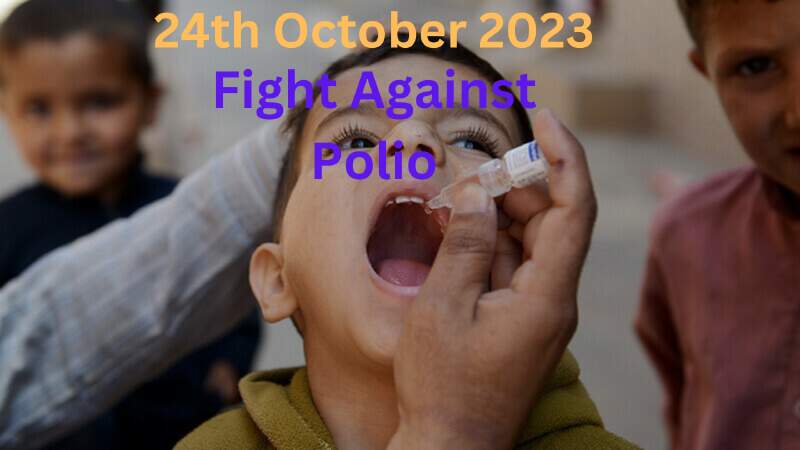Polio, short for poliomyelitis, is a crippling and life-threatening disease that has plagued humanity for centuries. This highly infectious ailment primarily targets young children, attacking the nervous system, and often leading to spinal and respiratory paralysis, and in severe cases, death. Although it has been present since prehistoric times, the formal recognition and understanding of polio as a medical condition began in the 18th and 19th centuries. This article delves into the history of polio, its devastating impact on communities worldwide, and the remarkable journey toward its eradication.
Contents
- 1 Historical Peril Of Polio
- 2 First Vaccine Against Polio
- 3 The Oral Polio Vaccine
- 4 The Power of Mass Vaccination and International Cooperation
- 5 Global Initiatives for Polio Eradication
- 6 The Unprecedented Success of the 21st Century
- 7 The Challenge of Circulating Vaccine-Derived Polioviruses (cVDPVs)
- 8 World Polio Day October 24th
- 9 Importance of World Polio Day
- 10 Current Status of Polio Eradication
- 11 Ongoing Challenges and Future Prospects
- 12 Achieving a Polio-Free World
- 13 Conclusion
Historical Peril Of Polio
Polio’s historical footprint is etched in ancient Egyptian images depicting children with withered limbs, a characteristic sign of the disease. Despite its long history, the first known clinical description did not occur until 1789 when British physician Michael Underwood documented its symptoms. It was not until 1840 that German physician Jakob Heine formally recognized polio as a distinct medical condition.
The late 19th and early 20th centuries witnessed frequent and devastating polio epidemics, making it one of the most dreaded diseases worldwide. The outbreak in New York City in 1916 claimed over 2,000 lives, and the United States saw its worst polio outbreak in 1952, leading to the deaths of more than 3,000 individuals. By the mid-20th century, the poliovirus had a global presence, claiming the lives of over half a million people each year. The absence of a cure and the escalating frequency of epidemics underscored the pressing need for a polio vaccine.
First Vaccine Against Polio
The breakthrough in the fight against polio came in 1949 when John Enders, Thomas Weller, and Frederick Robbins successfully cultivated the poliovirus in human tissue at Boston Children’s Hospital. Their pioneering work earned them the Nobel Prize in 1954.
In the early 1950s, American physician Jonas Salk developed the first effective polio vaccine. Salk conducted initial tests of his inactivated polio vaccine (IPV) on himself and his family in 1953. By 1954, he extended the testing to 1.6 million children across Canada, Finland, and the United States. On April 12, 1955, the results were announced, and the IPV received its license on the same day. The impact was swift, as annual polio cases in the U.S. dropped from 58,000 to 5,600 by 1957, and by 1961, only 161 cases remained.
The Oral Polio Vaccine
A complementary approach to polio vaccination emerged with the development of the oral vaccine (OPV) by physician and microbiologist Albert Sabin. Unlike the IPV, Sabin’s vaccine used live-attenuated (weakened) virus and could be administered orally, typically as drops or on a sugar cube.
Sabin’s vaccine faced initial skepticism as the Salk vaccine gained wide acceptance by the late 1950s. However, the live-attenuated vaccine had promising potential. Hilary Koprowski conducted the first human trials of a live-attenuated vaccine in 1950, and Sabin tested his vaccine on himself and his family. Trials conducted in the Soviet Union and Czechoslovakia in the late 1950s endorsed the safety and effectiveness of Sabin’s OPV. Independent review of these trials by United States specialist Dorothy Horstmann further validated the results during the Cold War era.
The Power of Mass Vaccination and International Cooperation
The ease of administering the oral vaccine made it ideal for large-scale vaccination campaigns. Hungary began using OPV in December 1959, followed by Czechoslovakia in early 1960, making it the first country to eliminate polio.
In 1962, Cuba launched nationwide immunization programs using the OPV. A distinctive advantage of the OPV was its ability to interrupt the chain of poliovirus transmission, a key factor in stopping outbreaks. In contrast, the IPV protected only the vaccinated child but did not prevent the virus from spreading among unvaccinated individuals.
Global Initiatives for Polio Eradication
The path to eradicating polio received a significant boost when Rotary International initiated a multi-year project in 1979 aimed at immunizing six million children in the Philippines. In 1988, the World Health Assembly passed a resolution to eradicate polio, setting the ambitious goal of permanent reduction to zero, with no risk of reintroduction.
The World Health Organization (WHO) played a central role in supporting global collaboration, facilitating vaccine production expansion on a global scale, with a particular focus on countries like India and Indonesia. By 1995, mass vaccination campaigns were underway in China and India. By 1994, polio had been eliminated from the Americas, and by 2000, the Western Pacific region became free. As of 2003, polio remained endemic in only six countries, a number that dwindled to four by 2006.
The Unprecedented Success of the 21st Century
The 21st century marked significant progress in the fight against polio. In less than two decades, cases were reduced by over 99% worldwide. WHO’s South-East Asia region was certified polio-free in 2014, followed by the African region in 2020. The Eastern Mediterranean region has successfully limited the virus’s presence to just a handful of districts. As of July 2021, only two cases of wild poliovirus have been reported globally, one in Afghanistan and one in Pakistan.
The Challenge of Circulating Vaccine-Derived Polioviruses (cVDPVs)
While the oral polio vaccine has played a pivotal role in reducing polio cases, it poses a unique challenge. In areas with low vaccination coverage, the weakened vaccine virus present in the OPV can circulate among under-vaccinated populations. Over time, this circulating vaccine-derived poliovirus (cVDPV) may genetically revert to a ‘strong’ virus, capable of causing paralysis. Adequate population immunization is essential to protect against both wild and vaccine-derived polioviruses. The presence of cVDPVs emphasizes the need for sustained vaccination efforts to minimize the risk of resurgence.
World Polio Day October 24th
Every year on October 24th, World Polio Day is observed to honor the remarkable progress made in the fight against polio and to raise awareness about the importance of continued efforts to eradicate the disease. This date holds special significance as it coincides with the birth of Jonas Salk, the pioneer of the inactivated polio vaccine (IPV). World Polio Day serves as a reminder of how far the world has come in eliminating this crippling disease and how close we are to achieving a polio-free planet.
Importance of World Polio Day
Raising Awareness: World Polio Day provides an excellent opportunity to educate people about polio, its history, the available vaccines, and the challenges that remain. Increased awareness is vital in ensuring that communities remain committed to vaccination campaigns.
Celebrating Progress: It’s a day to celebrate the substantial progress made in the fight against polio. Many countries and regions have been declared polio-free, and the number of cases has dwindled significantly.
Mobilizing Resources: World Polio Day is often a focal point for fundraising and advocacy efforts. Donors, organizations, and governments come together to pledge support for vaccination campaigns and research.
Honoring Frontline Workers: The day recognizes the dedicated healthcare workers and volunteers who tirelessly administer vaccines in the most challenging conditions, often in remote or conflict-affected areas.
Inspiring Action: World Polio Day serves as a call to action for individuals, communities, and governments to remain vigilant and committed to the cause until it is completely eradicated.
Current Status of Polio Eradication
As of the most recent updates, the progress towards global polio eradication remains impressive. The number of reported wild poliovirus cases has continued to decline, with the majority of the remaining cases concentrated in specific regions, most notably in Afghanistan and Pakistan. These countries continue to face challenges in reaching all children with vaccination due to security concerns and limited access in some areas.
However, the global commitment to eradication remains strong. The World Health Organization (WHO), Rotary International, the Bill and Melinda Gates Foundation, the Centers for Disease Control and Prevention (CDC), and UNICEF are among the organizations leading the charge. These entities coordinate vaccination campaigns, research, and advocacy efforts.
Ongoing Challenges and Future Prospects
While significant strides have been made in the fight against polio, some challenges persist:
Vaccine Hesitancy: Vaccine hesitancy is a global concern, and it affects the vaccination efforts as well. Misinformation and mistrust can deter parents from getting their children vaccinated.
Conflict Zones: vaccination campaigns in conflict-affected regions are fraught with challenges. Ongoing violence and insecurity can impede the ability of healthcare workers to access vulnerable populations.
Hard-to-Reach Areas: In some remote or isolated regions, reaching children with vaccines remains a logistical challenge. Infrastructure, access, and geography can pose significant barriers.
Circulating Vaccine-Derived Polioviruses (cVDPVs): As mentioned earlier, the continued use of the oral vaccine (OPV) can lead to the emergence of cVDPVs in under-vaccinated communities. Controlling these viruses is a complex task.
However, there is reason for optimism. With sustained global cooperation and innovative approaches, these challenges can be overcome. The world has been successful in the past in eliminating polio from large parts of the globe.
Achieving a Polio-Free World
The vision of a polio-free world is within reach. Significant progress has been made, and many countries have been declared polio-free. It’s essential to maintain the momentum, address the remaining challenges, and prioritize vaccination campaigns in the last strongholds of the disease. Here are key strategies for moving forward:
High-Quality Vaccination Campaigns: Ensuring that vaccination campaigns are of the highest quality, with particular attention to areas with limited access or ongoing conflict.
Community Engagement: Building trust in communities and addressing vaccine hesitancy through education and community engagement.
Global Solidarity: Continued commitment and support from international organizations, governments, and donors to fund vaccination programs and research.
Research and Surveillance: Vigilant surveillance to quickly detect and respond to any outbreaks, along with ongoing research to develop more effective vaccines.
Also Visit: Champions in the Making: ICC Cricket World Cup 2023
Conclusion
The history of polio is one of devastating epidemics, tireless dedication, and remarkable scientific achievement. The development of the IPV and OPV, along with unprecedented international cooperation, has brought the world tantalizingly close to eradicating this once-feared disease. As we stand on the brink of a polio-free world, it is essential to remain committed to vaccination efforts and to address the challenges posed by cVDPVs. The lessons learned from the fight against polio provide a blueprint for addressing other global health challenges. With the collective efforts of nations, organizations, and individuals, we can consign polio to history and demonstrate that humanity’s capacity for cooperation and innovation knows no bounds.

